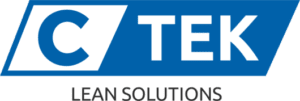3 lean manufacturing tools
Lean manufacturing is one of the top practices in the manufacturing industry today. Lean is an entire system designed to eliminate waste, improve efficiency, build customer trust and satisfaction, and ultimately improve a business’s bottom line. It’s easy to think of lean manufacturing as a toolbox that contains a number of different “tools” to help you get the job done. The experts at C Tek Lean Solutions will happily fill you in on the various tools that you can use in lean and the benefits they offer for your daily operations and overall success as a company.
Lean Tools
There are many different tools that you can use for lean manufacturing. No matter what kind of lean tools you use, all are designed to decrease uselessness, which is also considered a type of waste. Ultimately, they seek to remove processes and business operations that do not create value. Lean tools can apply to many different businesses and industries, ranging from traditional manufacturing to engineering companies and even finance. Quite often, they are used in conjunction with Six Sigma methods, which have complimentary philosophies.
Types of Tools
No matter what kind of lean tool you use, you’ll find that it has a number of useful and relevant applications.
Bottleneck Analysis
The principle behind the bottleneck analysis, which is an important and popular tool in lean, is simple. Ultimately, it seeks to find blockages that happen somewhere between product development and the end delivery. Bottleneck analysis is the art of looking at a process or multiple processes within your business and looking for ways to improve the workflow to produce a service or product with greater efficiency. The bottleneck analysis is used to identify and eliminate present as well as future issues. By finding and fixing a bottleneck, a lean company will save time, money, and energy from product production to delivery. If the problem is ultimately inefficiency, streamlining and improving the process can help. A lack of resources may be rectified by purchasing more technology or hiring more employees to expand upon existing resources.
Just-in-Time
Just-in-Time, or JIT, is another handy tool in the Lean toolbox. Just-in-Time manufacturing is the principle that companies should produce products when they are requested by customers, but they should not produce a surplus before that demand occurs. Otherwise, they run the risk of draining precious resources and producing waste. JIT works by triggering the production cycle when a customer demands a product. Companies don’t have to stock up on unnecessary inventory in advance, which reduces the likelihood that products and components will become damaged in storage. JIT is often used in situations where a business can use an on-demand method of production and reduce the risk of carrying excess inventory. In this case, JIT can be an effective solution for inventory management. However, one risk is that it can become difficult to satisfy customer demand if a breakdown occurs somewhere in the supply chain.
Overall Equipment Effectiveness
Overall Equipment Effectiveness, or OEE, is another lean tool. OEE essentially measures the actual amount of productive time compared to planned productive time. For instance, if an employee plans to work on a project without interruption for 60 minutes but ends up answering phone calls or responding to a customer request that takes 20 minutes, the employee loses over 30% of the intended productivity time. Additionally, OEE considers the three factors of quality, performance, and availability to determine the number of “good” parts that are ultimately produced. OEE considers “good” parts to be those that meet a company’s quality standards. If parts are poorly designed or constructed, they do not count towards the total OEE score.
To learn more about lean and develop an effective lean toolkit, contact C Tek Lean Solutions today.
